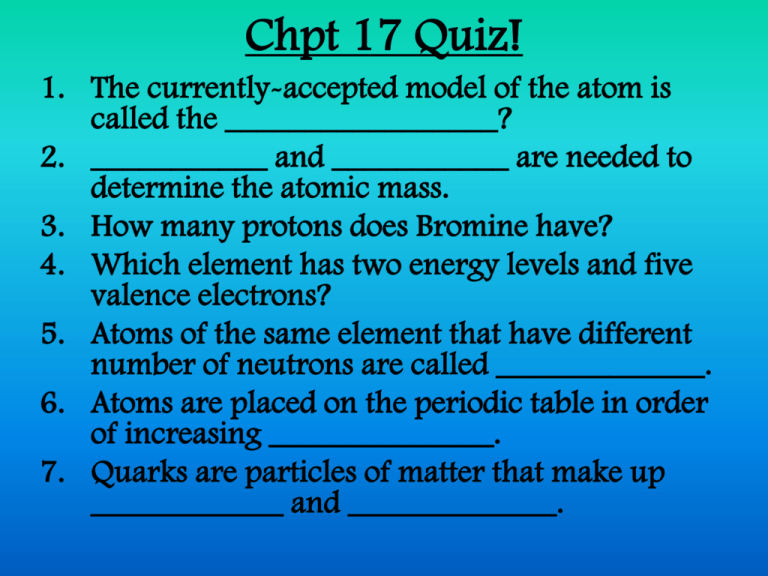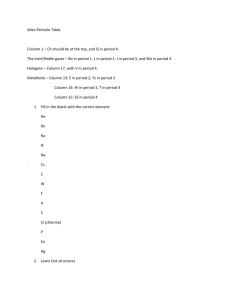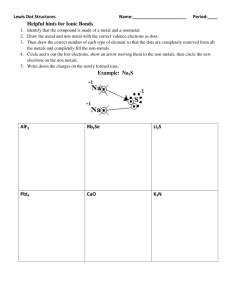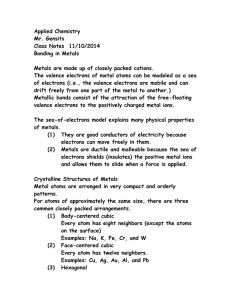Density
advertisement

Chpt 17 Quiz! 1. The currently-accepted model of the atom is called the _________________? 2. ___________ and ___________ are needed to determine the atomic mass. 3. How many protons does Bromine have? 4. Which element has two energy levels and five valence electrons? 5. Atoms of the same element that have different number of neutrons are called _____________. 6. Atoms are placed on the periodic table in order of increasing ______________. 7. Quarks are particles of matter that make up ____________ and _____________. Trends in the Periodic Table Metals 1. ¾ of the elements are metals • Not all metals are hard • Ex: Manganese- the metal that isn’t • It behaves like the transition elements only when its alloyed with other metals, then it adds strength and flexibility 2. Shiny (silvery metallic luster) 3. Most are solids at room temperature 4. Good conductors of heat and electricity 5. Malleable- can be flattened into sheets 6. Ductile- can be stretched into wire 7. Can give up valence electrons easily Group 1 Alkali Metals • Have similar properties because each has only one valence electron • Soft metals • Extremely reactive- single electron can be removed easily • Ex: if you drop a small piece of an alkali metal into water, it will react violently as it forms a compound • Na & K- essential part of our diet • Control movement of fluid, transmit nerve impulses, control muscles Group 2 Alkaline Earth Metals • 2 valence electrons- close cousins of the alkali metal group •Added electron makes them slightly less reactive •Still not found as free elements in nature •Examples: •Be- used to harden metal alloys •Mg- medicinal purposes, fireworks •Ca- used for structural purposes in people and buildings Groups 3-12 Transition Elements • Sometimes called subgroups- have either 1 or 2 electrons in the outer shell •Most have similar properties •Strong metals •Iron Triad- iron, cobalt, & nickel •Common uses: metal mixtures (alloys) •Sterling silver- copper, silver, gold •Gold in jewelry- gold, silver, copper Inner Transition Metals • The periodic tables usually isn’t shown with the inner transition elements positioned where they should be to save space. • Lanthanides- atomic #s 58-71 – Uses: produce colors for TV and movies • Actinides- atomic #s 90-103 – All are radioactive and unstable – Uses: glass for camera lenses and nuclear reactors Nonmetals 1.Hydrogen and the elements on the right side of the table (17 of them) 2.Hold electrons tightly • Are more likely to take electrons from metals than give them up 3.At room temp, most are gases and some are brittle solids 4.Do not conduct heat and electricity well Group 17 Halogens • Have 7 valence electrons •Very reactive chemically (WHY???) •Very distinct properties that change with the atoms’ size •As atomic # increases, elements get denser, color gets darker, phase changes occur •Very dangerous in strong concentrations •Chlorine used as poisonous gas in WWI •Useful in weaker concentrations: •Cl- kills germs •F- prevents tooth decay •I essential nutrient (hyperthyroidism) Group 18 Noble Gases •8 valence electrons- outermost energy level is full! •Very nonreactive- allows them to exist in nature as pure substances •Uses: •Neon & Argon- neon lights •Helium- balloons & blimps •Krypton- light in lasers Metalloids 1. Have both metallic and nonmetallic properties 2. A heavy line divides the metals and nonmetals on the right-hand side of the table 3. Semiconductors- between a conductor and an insulator can be controlled • Without semiconductors, we would not have watches, pocket calculators, or microcomputers Group 13 The Boron Group • Have 3 valence electrons •Contains metalloids- elements that have both metal and nonmetal characteristics •Can form covalent and ionic bonds •Ex: Boron •Aluminum- most abundant metal in earth’s crust •Used in pots and pans Group 14 Carbon Group • Allotropes- different forms of the same element (different molecular structures) • Silicon: occurs as two allotropes 1. A hard, gray substance 2. A brown powder • Carbon: 1. Diamond- clear and extremely hard - each carbon atom is bonded to four other carbon atoms 1. Graphite- a black powder - Each carbon atom is bonded to three other carbon atoms Group 14 Carbon Group • Have 4 valence electrons •Few other similarities- Group contains nonmetals, metalloids, and metals •Uses: •Carbon- occurs in coal, oil, natural gas, and foods •Tin- coat other metals to prevent corrosion •Included in bronze and pewter alloys •Lead- used to be used in paint •Silicon- 2nd most abundant element in Earth’s crust •Main component in semiconductors Group 15 Nitrogen Group • Have 5 valence electrons •Elements tend to share electrons •Make covalent compounds •Uses: •Nitrogen- abundant in air and human bodies •Phosphorus- fertilizer, match heads •Antimony & Bismuth- used with other metals to lower melting points Group 16 Oxygen Group • Have 6 valence electrons •Most share electrons when they bond •Diatomic molecules- consist of two atoms of the same element in a covalent bond •Uses: •Oxygen- needed for respiration •Sulfur- pigments in paint •Selenium- multivitamins, copy machines







